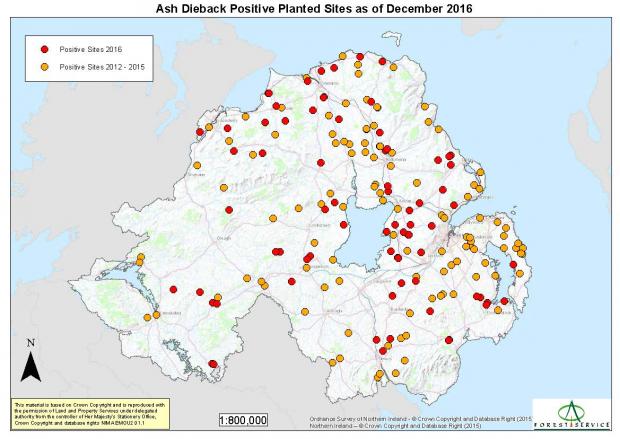Further information on the disease and symptoms can be found on Information on Ash Dieback (Forestry Commission website)
A copy of the Forest Research Rapid Assessment on the disease is available at Forest Research Rapid Assessment.
The call comes following three new tree and shrub species in the same family as ash (Oleaceae) testing positive for ash dieback in England in early August 2018. The infection was identified on mock privet, narrow leaved privet and white fringetree all of which were in close proximity to infected ash trees.
Further information can be found on the following link three new ash dieback hosts discovered.
Current situation in Northern Ireland
Results from the 2016 Chalara Ash Dieback Survey indicate further spread of the disease to native ash in the wider countryside. Whilst this is disappointing it is not unexpected given the experience of the spread of the disease in Continental Europe and Great Britain.
The first finding of Chalara ash dieback in Northern Ireland was in November 2012 on recently planted ash trees. At 1 December 2016 a total of 176 premises with recently planted ash and 3 nursery findings have infection confirmed.
From 2012 to 2015 Forest Service inspectors found Chalara ash dieback on 111 sites, including 81 in forestry plantations. Other sites included 3 in horticulture nurseries and in trade, 10 in urban amenity settings, 3 on roadsides, 10 in private gardens and 4 in recently planted hedgerows.
As a result of buffer surveillance at affected sites in 2015, Ash Dieback was detected in mature hedgerow ash trees at 3 locations close to infected recently planted trees, suggesting very localised spread at that stage.
The 2016 Ash Die-back survey consisted of 2,680 inspections across Northern Ireland focused on Woodland Grant Scheme plantations, buffer surveys of previously and newly discovered infected plantations, intelligence-based general surveillance and stakeholder report follow-up. The 2016 survey was also designed to determine more fully the extent of any spread of Ash Dieback to native ash in the wider environment. As a result of this survey, ash plantations at 68 premises tested positive for the disease.
| Year | Inspections | Positive infections at planted sites (premises) | Positive infections at nursery/retail/trade |
|---|---|---|---|
| 2012 | 1028 | 76 | 3 |
| 2013 | 1895 | 12 | 0 |
| 2014 | 1306 | 2 | 0 |
| 2015 | 1896 | 18 | 0 |
| 2016 | 2680 | 68 | 0 |

The map below shows 10km Irish Grid squares in which at least one confirmation of ash dieback infection in native ash trees has been made.

In response to the 2016 survey findings and ongoing scientific advice, Forest Service Plant Health Directorate are reviewing the approach to the changing Chalara Ash Dieback disease situation. This will include reassessing the objectives of the All Ireland Chalara Control Strategy with DAFM to ensure an appropriate integrated all island response. Further details will be placed on this site when finalised.
Current situation in the UK
The forestry commission have completed a survey of Ash dieback confirmed findings across the UK as a whole. As of September 2018, 49.2% of the UK landmass, split by 10km grid squares, was found to have been infected. A map can be viewed by clicking here.
Suspect symptoms
Signs of the disease include:
- diseased saplings typically display dead tops and/ or side shoots at the base of dead side shoots, lesions can often be found on the subtending branch or stem
- lesions which girdle the branch or stem can cause wilting of the foliage above
- mature trees affected by the disease initially display dieback of the shoots and twigs at the periphery of their crowns. Dense clumps of foliage may be seen further back on branches where recovery shoots are produced
A video showing symptoms is available below:
Biosecurity
There are things you can do to prevent pests and diseases spreading from site to site.
For advice on working in forests/woods, see attached Biosecurity Guidance
For visitors to the countryside, see link below on tree health and biosecurity
Tree Health Biosecurity Poster
For review on biocide and disinfectant treatment on Ash dieback, see
Efficacy of biocides and disinfectants on chalara fraxinea (AFBI report)
